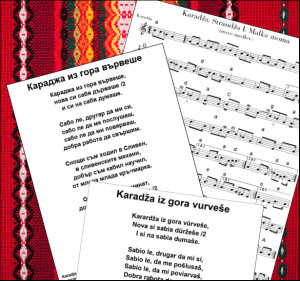
This issue’s Balkan Song selection is a medley of three Bulgarian pravo tunes—one instrumental tune and two songs.
 I put this pravo medley together as a musical spot when I was Music Director of Aman in the early '80s, when we were privileged to perform for the first three months of the opening of Disney World's Epcot Center. The medley was structured to enable folks to hear three of the main melodic modes heard in Bulgarian music: Karadzha is in Phrygian/kürdi; Strandzha I (in this arrangement) starts major but ends minor; and Malka Moma is in hijaz.
I put this pravo medley together as a musical spot when I was Music Director of Aman in the early '80s, when we were privileged to perform for the first three months of the opening of Disney World's Epcot Center. The medley was structured to enable folks to hear three of the main melodic modes heard in Bulgarian music: Karadzha is in Phrygian/kürdi; Strandzha I (in this arrangement) starts major but ends minor; and Malka Moma is in hijaz.
Recordings provided here are for the three individual tunes. (Ed. note: The transliteration style used for the file names below diverges from Kef Times style.)
Sheet Music
Pravo Medley
MP3s
- Karadzha iz gora vurveshe - Nedyalka Keranova (Vocals) & Kosta Kolev Orch - Balkanton BHA 1682
- Strandžansko horo - Georgi Slavov 1971 Note: This recording was provided by Mark Levy, who recorded it in 1971 in Selo Kameno, Burgasko. Mark says, "We played this tune a lot in the Pitu Guli* days, and began calling it 'Strandžansko horo #1' to differentiate it from the other Strandžansko horos we played." Note that just the first portion of the music from this recording is included in the Pravo Medley.
- Malka moma v gradinchitsa - Yordanka Ilieva (vocals) & Bitov Ensemble - Balkanton BHA 11230 - Yordanka Ilieva
Lyrics and Translations
Karadzha iz gora vurveshe - lyrics in Cyrillic and Latin letters + translation
Malka moma v gradincica - lyrics in Cyrillic and Latin letters + translation
[KT Editor's note: Thanks to Mark Levy and Rachel MacFarlane for assistance with these materials.]
* Pitu Guli, named after a hero of the anti-Ottoman resistance movement in Macedonia, was a band made up of American musicians in Southern California who started playing Bulgarian and Macedonian music on folk instruments in around 1970.
 Bill Cope is a multi-instrumentalist who began playing Balkan music in 1975 and teaching at the Balkan Music & Dance Workshops in 1982. He’s made numerous trips to the Balkans and has studied and performed with many noted players and singers. Read a profile about him in the Spring 2007 Kef Times.
Bill Cope is a multi-instrumentalist who began playing Balkan music in 1975 and teaching at the Balkan Music & Dance Workshops in 1982. He’s made numerous trips to the Balkans and has studied and performed with many noted players and singers. Read a profile about him in the Spring 2007 Kef Times.
Bill is editor of Kef Times’ Balkan Songs. If you have an idea and transcriptions, translation and background for a song to be featured in a future issue, please contact him.


 “In addition to having a great sing-along chorus, Dhimitrúla is special to me because it’s one of the few songs I know of that actually mentions the word kéfi, that ‘frame of mind, a good mood or spirit, considered essential before the music-making can begin’—to quote my own liner notes.”
“In addition to having a great sing-along chorus, Dhimitrúla is special to me because it’s one of the few songs I know of that actually mentions the word kéfi, that ‘frame of mind, a good mood or spirit, considered essential before the music-making can begin’—to quote my own liner notes.”